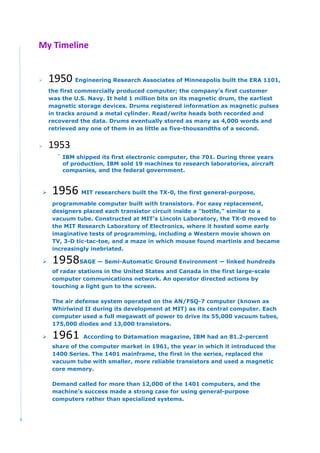
1950-1975
- 1. My Timeline 1950 Engineering Research Associates of Minneapolis built the ERA 1101, the first commercially produced computer; the company’s first customer was the U.S. Navy. It held 1 million bits on its magnetic drum, the earliest magnetic storage devices. Drums registered information as magnetic pulses in tracks around a metal cylinder. Read/write heads both recorded and recovered the data. Drums eventually stored as many as 4,000 words and retrieved any one of them in as little as five-thousandths of a second. 1953 ` IBM shipped its first electronic computer, the 701. During three years of production, IBM sold 19 machines to research laboratories, aircraft companies, and the federal government. 1956 MIT researchers built the TX-0, the first general-purpose, programmable computer built with transistors. For easy replacement, designers placed each transistor circuit inside a quot;bottle,quot; similar to a vacuum tube. Constructed at MIT’s Lincoln Laboratory, the TX-0 moved to the MIT Research Laboratory of Electronics, where it hosted some early imaginative tests of programming, including a Western movie shown on TV, 3-D tic-tac-toe, and a maze in which mouse found martinis and became increasingly inebriated. 1958SAGE — Semi-Automatic Ground Environment — linked hundreds of radar stations in the United States and Canada in the first large-scale computer communications network. An operator directed actions by touching a light gun to the screen. The air defense system operated on the AN/FSQ-7 computer (known as Whirlwind II during its development at MIT) as its central computer. Each computer used a full megawatt of power to drive its 55,000 vacuum tubes, 175,000 diodes and 13,000 transistors. 1961 According to Datamation magazine, IBM had an 81.2-percent share of the computer market in 1961, the year in which it introduced the 1400 Series. The 1401 mainframe, the first in the series, replaced the vacuum tube with smaller, more reliable transistors and used a magnetic core memory. Demand called for more than 12,000 of the 1401 computers, and the machine’s success made a strong case for using general-purpose computers rather than specialized systems.
- 2. 1964 IBM announced the System/360, a family of six mutually compatible computers and 40 peripherals that could work together. The initial investment of $5 billion was quickly returned as orders for the system climbed to 1,000 per month within two years. At the time IBM released the System/360, the company was making a transition from discrete transistors to integrated circuits, and its major source of revenue moved from punched-card equipment to electronic computer systems. 1967The Department of Defense Advanced Research Projects Agency contracted with the University of Illinois to build a large parallel processing computer, the ILLIAC IV, which did not operate until 1972 at NASA’s Ames Research Centre. The first large-scale array computer, the ILLIAC IV achieved a computation speed of 200 million instructions per second, about 300 million operations per second, and 1 billion bits per second of I/O transfer via a unique combination of parallel architecture and the overlapping or quot;pipe-liningquot; structure of its 64 processing elements. This photograph shows one of the ILLIAC’s 13 Burroughs disks, the debugging computer, the central unit, and the processing unit cabinet with a processing element. 1971 The Kenbak-1, the first personal computer, advertised for $750 in Scientific American. Designed by John V. Blankenbaker using standard medium-scale and small-scale integrated circuits, the Kenbak-1 relied on switches for input and lights for output from its 256-byte memory. In 1973, after selling only 40 machines, Kenbak Corp. closed its doors. 1973 The TV Typewriter, designed by Don Lancaster, provided the first display of alphanumeric information on an ordinary television set. It used $120 worth of electronics components, as outlined in the September 1973 issue of Radio Electronics. The original design included two memory boards and could generate and store 512 characters as 16 lines of 32 characters. A 90-minute cassette tape provided supplementary storage for about 100 pages of text. 1975 The January edition of Popular Electronics featured the Altair 8800 computer kit, based on Intel’s 8080 microprocessor, on its cover. Within weeks of the computer’s debut, customers inundated the manufacturing company, MITS, with orders. Bill Gates and Paul Allen licensed BASIC as the software language for the Altair. Ed Roberts invented the 8800 — which sold for $297 or $395 with a case— and coined the term quot;personal computer.quot; The machine came with 256 bytes of memory (expandable to 64K) and an open 100-line bus structure that evolved into the S-100 standard. In 1977, MITS sold out to Pertec, which continued producing Altairs through 1978. I got all my information cut and paste from this website http://www.computerhistory.org/timeline/?year=1975